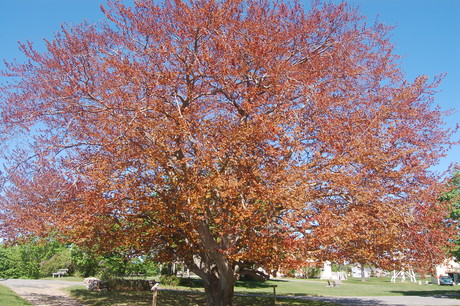The Wrack
The Wrack is the Wells Reserve blog, our collective logbook on the web.
The Wrack is the Wells Reserve blog, our collective logbook on the web.
Appearing as wide as it is tall, the Wells Reserve's copper beech tree is a dominant presence on the campus, commanding the same respect from many of our visitors as the human-made historic structures or other natural features on the property. As befits a tree with such stature, the Reserve's beech has an interesting cultural and natural history.

The venerable copper beech tree is not native to North America and bears the name European beech (Fagus sylvatica). This species was introduced by settlers centuries ago and has been used primarily as an ornamental or shade tree. One notable copper beech was at Abraham Lincoln's cottage (known as his summer White House) in Washington D.C. He would often seek refuge under the tree's shade to escape the pressures of the Civil War.
The European beech is a close cousin of the American beech (Fagus grandifolia), though our native tree thrives best in wild, forested habitats and is not easily cultivated. The European beech, on the other hand, is perfectly at home in the company of humans.
Beeches are long-lived trees that reach biological maturity at 120 years, but could live much longer if conditions are favorable. They can grow to a height of over 80 feet and reach a circumference greater than 10 feet. While it is only about 40 feet tall, the Reserve's beech is more than 10 feet around. Its trunk appears to have received a couple of grafts at some point in its history, which adds to its substantial girth.
The leaves of the Reserve's European beech turn a deep purple in late spring, and transform into a rusty color in the fall. In autumn, the tree produces countless small spiny husks that contain nuts, which are fed on by a range of wildlife species.
The presence of the beech at the Reserve is the result of the Lord family's fondness for this type of tree. They had a European beech in their Newton, Massachusetts yard and wanted one at the Maine home, too.
Nathaniel Lord says the beech at the Reserve was planted by his father, George Lord II, probably around 1915. He says his father planted it because he knew kids liked to climb trees, and the beech is conducive to climbing. "Its bark is nice and smooth and its branches are low. It's an easy tree to climb," Nathaniel says.
As the Reserve's beech tree approaches the century mark, it appears to be holding up well, according to Tom Sukley, a horticulturist who examined the tree recently. While it may appear in good condition, the Reserve's beech tree does not have it made in the shade. It faces a variety of threats from fungi and insects—including the deadly beech scale (an insect) and bark canker (a fungus), which work in tandem to wound and even kill beech trees.
Sukley recommends some preventative medicine to keep the tree in good health, including aerating and fertilizing the soil and periodic pruning. "It does need some attention, particularly since beech trees are hard to turn around once they're in decline," Sukley says.
Nathaniel Lord appreciates the tree's endurance. "It has grown a lot in the last 80-plus years," he says. He and many others associated with Laudholm's history hope that the beech will continue to thrive, commanding respect for years to come.